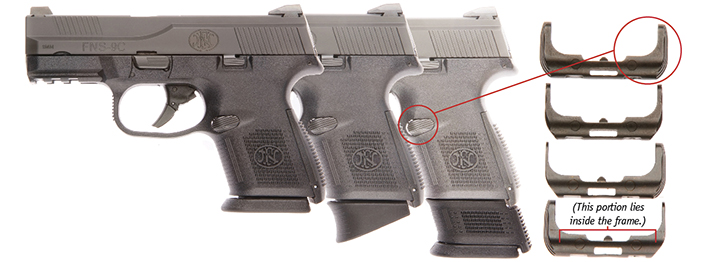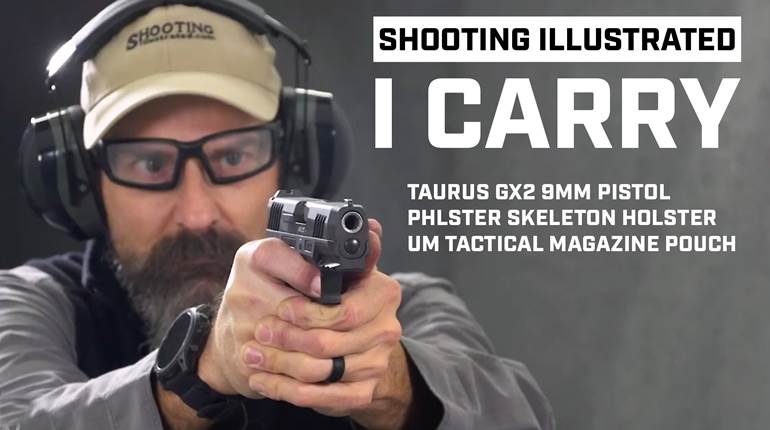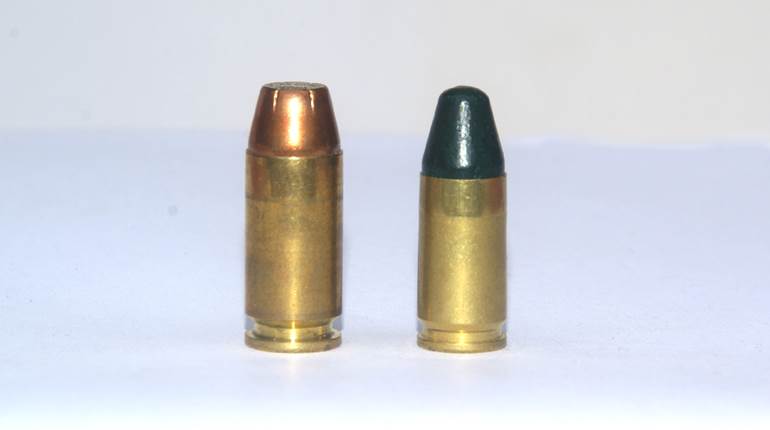
Geared for concealed carry, the FNS Compact exhibits bilateral controls and modular features to perform both on the range and in more discreet defensive roles.
The FN line of polymer-frame pistols may not be the most advertised or the most recognized from movies or television, but for those who own and know them they are highly regarded. After the striker-fired FNS was introduced in 2011, FN engineers could have taken the path of least resistance and quickly designed variants demanded by the market. But that would not have been consistent with the company’s engineering philosophy of pushing the limits to improve mechanisms, designs and materials. And that kind of approach takes time.
Like all of the FNS pistols, the 5"-barreled Longslide variant was created with the needs of law enforcement and competition shooters in mind, but also to showcase FN’s capability to produce extremely accurate pistols. And its development took two years. The effort paid off in the form of adoption by the Arizona Department of Public Safety and Baltimore County, Md., and Hillsborough County, Fla., law enforcement agencies. On the competition side, the pistol further proved itself with Dave Sevigny taking second place in the Production Division at the 2015 Bianchi Cup. Still more development went into the FNS Compact, which was introduced in January of last year. For three years, a dedicated team of engineers sought to maximize the gun’s reliability, durability and ergonomics.
Fabrique Nationale has a long history of implementing its own testing standards, and those used by the company today both in Herstal, Belgium, and in the United States are derived from NATO requirements. They include testing in adverse conditions, and they are more rigorous than the guidelines many manufacturers use.
The FNS Compact is the most tested of FN’s polymer pistols. In development stages alone, 750,000 rounds were fired from prototypes and pre-production pistols in 9 mm Luger and .40 S&W. Once the Compact model was finalized, the company put the pistols through additional endurance testing, ultimately firing more than 1 million rounds before offering the first gun for sale.
Before production started, FN invited a select group of law enforcement officers to provide feedback on the trigger pull and trigger mechanism. Their observations were quite subjective—but also constructive. Some officers compared the prototype’s trigger pull to that of their service pistols that had been broken in for years, resulting in a trigger that felt smooth to the user, yet with a release weight that was not too light for law enforcement use in stressful situations.
I surveyed a sampling of shooters as to what they liked about the gun and concluded that the subjective preferences were not the result of design coincidences but were carefully weighed developments. The FN’s hinged trigger safety is preferable to some than a blade safety insert because it gives the shooter a better feel for where the trigger breaks. The Compact’s fast-yet-precise trigger reset is also one of its positive features. That combined with very low perceived recoil—even in .40 S&W—allows for better trigger control, follow through and shot placement.
When discussing the low perceived recoil with FN engineers, they stressed the relationship between the bore axis and the position of the shooter’s hand on the grip frame. The technical jargon boiled down to successfully reducing the distance between the moving mass—the slide—and the shooting hand. The closer that relationship, the less perceived recoil there is. The higher the recoiling slide is above the hand, the more it acts to tip the gun, therefore producing a greater sense of perceived recoil. Even a minute change in that dimension makes a noticeable difference.

While it is labeled a compact, it could be considered a subcompact as the grip does not facilitate the placement of the pinky on the frame. This leads to one of my favorite features of the FNS Compact. Having large hands, I struggle with compact and subcompact pistols—some grips are too small or wide—and I never seem to reach a comfortable compromise. This, too, is very subjective and differs from shooter to shooter. Recognizing that, FN supplies each pistol with two interchangeable backstraps and three different magazines—a 12-round (9 mm) flat-bottom magazine, a 12-round magazine with finger extension, and a 17-round FNS magazine with removable grip extension sleeve. The magazine capacities for the .40 S&W are 10 and 14 rounds, respectively. The different magazines allow the owner to choose a configuration for concealed carry, while the full-size FNS magazine is better-suited to target shooting or when concealment is not a necessity. The 17-round magazine is the standard FNS magazine, and the polymer grip sleeve is removable without tools. It is tight enough not to move around in your hand but loose enough for easy removal. It is worth mentioning that the grip sleeve is not required for operation, a standard FNS magazine works properly without it.
The safety lever is also a personal choice, the Compact is offered with or without bilateral external manual safeties. The internal safety mechanisms were subjected to numerous tests, and the FNS Compact passed both the SAAMI and NATO requirements, these include dropping the pistol loaded on concrete from a height of two meters (6.5 ft.). The loaded-chamber indicator is simple but effective, with the red extractor becoming visible when a round is chambered.
All FNS Compact pistols are equipped with 3.6", cold-hammer-forged, stainless-steel barrels that are produced on the same machines—and by the same technicians—that hammer-forge machine gun barrels for U.S. military M240 and M249 machine guns. The life cycle of the pistol is rated at 20,000 rounds, yet that has little bearing on what these pistols can actually achieve. In tests reaching 20,000 rounds, there was little degradation of barrel and lockup, and the guns’ accuracy was still within new-gun specifications. The barrels exhibited indications of surface wear more consistent with 5,000 rounds of use. This is a testimony to the quality of FN’s hammer-forged barrels.
The slides are made from stainless steel and are available in a matte black particle vapor deposition (PVD) finish or matte stainless finish. The frame, identical for both the 9 mm and .40 S&W, is constructed from glass-filled nylon, which has enhanced dimensional stability in extreme temperatures and atmospheric conditions. It is also equipped with replaceable rails that increase the service life of the pistol. Sight options include fixed three-dot combat sights or tritium night sights.

The gun is geared for concealed carry and has completely bilateral controls. Engineers developed high- and low-profile magazine release buttons as well as flush release buttons. This allows the user to replace the high-profile magazine-release button with the lower-profile version to avoid unwanted magazine releases typically encountered with concealed carry (holstering, car seat contact or seatbelt contact). The choice of buttons is both practical and a matter of personal preference.
Pistols in the FNS line, like most of FN’s polymer-frame pistols, are made in Columbia, S.C., are labeled “Made in America,” and meet Federal Trade Commission standards for products that are made and assembled in America from 100 percent domestically sourced parts and materials. This distinction is important as more and more manufacturers assemble guns from parts sourced in foreign countries and finish them in the United States under the “Made in America” banner.
The pistol line at the South Carolina factory is on the second level of the production floor, just above the assembly of the M240 machine guns. Assembly and testing is performed by a small team that works in an intimate, U-shaped setting. There is no conveyer belt; partially completed parts and pistols are passed on by hand from Fire Control, Frame Assembly and Slide Assembly. Master builders do the final assembly and test the completed pistol, including verifying trigger pull. Communication is key, and the team members rely on each other to keep assembly going. Completed pistols go from assembly to the firing range where they are tested for function and accuracy before moving on to the packaging department where they are cleaned before being boxed up with accessories.
While there are no differences between law enforcement, military or civilian production, FN will supply special features or training guns to law enforcement or military customers, this includes cut-away pistols and non-firing training pistols. The red training pistols are fully operational but lack the ability to strike the primer of a cartridge.
The FNS-9 Compact comes standard with the three various magazines (two 12-round capacity and one 17-round), one magazine sleeve, two interchangeable backstraps and a hard case. Optional configurations include night sights and the choice of the external safety lever. The standard configurations (9 mm or .40 S&W) with fixed combat sights have a suggested retail price of $599.
Fabrique Nationale is one of the world’s oldest pistol manufacturers, and its pistols always have had a reputation for quality. Through their performance, FN’s guns speak for themselves, and the FNS Compact appears to be following that tradition.
For more information, contact: FN America (Dept. AR), P.O. Box 9424, McLean, VA 22102; (703) 288-3500; fnamerica.com.






































